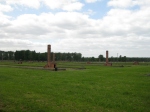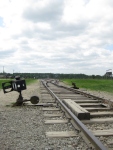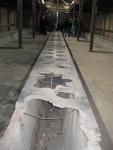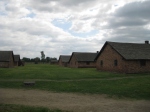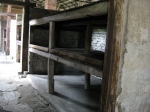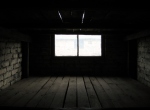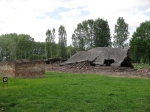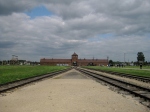Day 7 Cont’d (Auschwitz-Birkenau)

This work is licensed under a Creative Commons Attribution-NonCommercial-NoDerivs 3.0 Unported License.
For the post about Auschwitz I, please click here.
We left the infamous gas chamber / crematorium in KZ-Auschwitz and walked together back to the camp’s entrance not saying a word to one another. Each person had the same expressionless face as they either contemplated what they had just seen or couldn’t process anything because it didn’t seem possible. So much weighs on so few steps in and out of a building. But here stepping outside bears the weight of the would be’s, could be’s, and should-have-been of a myriad of people.
Eventually we left KZ-Auschwitz by bus and drove to Auschwitz-II, or Auschwitz-Birkenau. Our professors said that in the past their study tours walked from camp I to camp II, which is quite a lengthy walk. Although I do not know how long the bus ride lasted, it was long enough to affirm that walking would have taken up a lot of time. It made me also want to walk since no prisoner ever had the luxury of taking a bus, but for brevity’s sake, on we drove.
Our arrival at Auschwitz-Birkenau was again ripe with anticipation. Although every camp is a nightmare, Birkenau seems to be the icon of the Holocaust; more recognized (at least in name) than any other camp. My first impression of the place was that it was desolate in a different way from KZ-Auschwitz. Most of the buildings were destroyed during the bombing and what was left were stacks of bricks indicating where a barrack once stood. It gave an eery vibe seeing bricks rise into the air on a shaky foundation. Once again there was grass everywhere mixed with dust that rose up with each step. Had there been no grass today just as during the Holocaust, I’m not sure this place would have been bearable. The camp seemed to ache as it bore the burden of its hell for years and years.
We entered the few barracks that were still standing and stood dumbfounded looking at the living conditions. These people were treated as less than animals. What was originally supposed to be a horse stable was converted into a space where hundreds of people were crammed with no proper place to sleep, eat, rest, or even urinate. The Nazis made no attempt to cover up the stable’s intended use, as the tying rings for horses were still evident on the sides of the wall. Where there were wooden bunks, people were forced to sleep with as many as four others in a bunk, possibly more. The “latrines” in the next building were nothing more than holes cut out in rock with a collection point for sewage that was almost never collected. Prisoners were essentially forced to live in their own waste and often people died from disease in the camps.
We walked down the same dusty road alongside the train tracks that the newly arrived prisoners were made to stand on, ultimately being placed to the left or the right. The notorious SS doctor Josef Mengele separated people with a casual wave of the hand whereby people could be sent straight to their deaths. And he did it “carefully”! I felt rooted to the spot and listened to nothing as I stood there. People begged, pleaded, and bribed officials not to be separated from their family. And unbeknownst to the victims sometimes their pleading actually landed them in the group sent straight for the gas chambers.
The group continued around back of the camp to look at more barracks that were preserved. In these barracks the “beds” were made of bricks. The bricks were haphazardly put together and sometimes the weight of people above would cause the bricks to break crushing the people below. It was a sick sight to look into a brick bunk knowing thousands of people slept there and died there.
From the rear barracks we made our way to the sites of former gas chambers and crematoriums, all in ruin. Flowers and rocks were placed around the edges of the site honoring those who had been murdered. Originally the gas chambers were below ground level but because of the destruction we could look into them. How terrible it was for those prisoners to have to march all the way to the back of the camp and be told they were there to get a shower while smelling that awful smell from the crematorium.
On our last stop we visited the in-processing building housed way in the back of the camp. Here the prisoners who passed selection were given a cold shower and a hair cut (hair was shaved on women too). They also received a set of clothes, albeit from the prisoners who had died before them. If by chance a “defect” was found by the Nazis while in-processing, that person would be taken from the line and killed. Examples: a possible wound, a hidden pregnancy, a physical defect, etc).
It was ironic to have our last stop on the tour be the place where prisoners would first go for their doomed sentence. The walk to the entrance was probably a mile away and along the path back the group reflected over the day’s events. I do not see myself going back to Auschwitz again but I think everyone needs to visit. I have not given that much of a written description of Auschwitz I and II for a reason– because it simply does not have much for me to say. What can I say to do it justice? What can I say that conveys an event in history that is the most horrifying of mankind? I feel like a person of few words when I think about Auschwitz, but I think that is okay.
There is a real lesson to be learned here, especially for the people who still believe antisemitism is right or deny that the Holocaust happened. Auschwitz-Birkenau is a harrowing place. 1.2 million people were murdered on these grounds because they were unfit for society according to Nazi standards. As human beings, we never should have let that happen. And today, we should never let ourselves forget what happened. Walking around Auschwitz I and II is disturbing but almost necessary to carry on the stories of those who struggled, who survived, who passed. We have an obligation to never forget what happened and to never let it repeat itself. Unfortunately, our world is not perfect. We still have genocide and we still have repressive governments that continue to starve their own people, rape their women, and kill because their religion is “wrong.” We need difference in this world, we need diversity. Just because you are Jewish, a Jehovah’s Witness, handicapped, gay or lesbian, Eastern European, or whatever for that matter, does not mean that you are unfit to live in any society. Respect one another’s differences and learn from it. Do it for the 17 million people who wanted freedom, acceptance, and to be loved and never got it.
- Barrack remnants
- SS selection ground
Hovering over an image will allow you to see a description of what it is.


